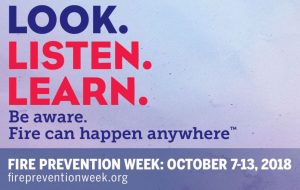 Each year, at the beginning of October, the National Fire Protection Association (NFPA) sponsors Fire Prevention Week; a campaign to raise awareness around fire safety and prevention. This year’s focus is “Look. Listen. Learn. Be aware. Fire can happen anywhere,” which is aimed at educating people about three basic but essential steps to take to reduce the likelihood of having a fire, and how to escape safely in the event of one.
Each year, at the beginning of October, the National Fire Protection Association (NFPA) sponsors Fire Prevention Week; a campaign to raise awareness around fire safety and prevention. This year’s focus is “Look. Listen. Learn. Be aware. Fire can happen anywhere,” which is aimed at educating people about three basic but essential steps to take to reduce the likelihood of having a fire, and how to escape safely in the event of one.
Since 1922, the NFPA has sponsored the public observance of Fire Prevention Week which is observed each year during the week of October 9th in commemoration of the Great Chicago Fire; started on October 8, 1871. Devastating damage was caused by this horrific event. More than 250 people were killed and 100,000 others were left homeless. Over 17,400 structures and 2,000 acres of land were destroyed. Because of its impact, in 1925, President Calvin Coolidge proclaimed Fire Prevention Week a national observance, making it the longest-running public health observance in the United States.
When a fire happens, just a few seconds can mean the difference between safety and tragedy. Fire safety education isn’t just for school children; teenagers, adults, and the elderly are also at risk in fires. Fire Prevention Week aims to make sure people of all ages, races, and socioeconomic status understand how to remain safe in case of a fire.
National Fire Protection Association Fire Facts
- U.S. fire departments respond to an average of one home fire every 86 seconds.
- On average, seven people per day die in U.S. home fires.
- Cooking is the leading cause of home fires and home-fire injuries.
- From 2011 to 2015, U.S. fire departments responded to an average of 466 home cooking fires per day.
- Thanksgiving is the peak day for home cooking fires, followed by the day before Thanksgiving, Christmas Day, and Easter.
- Heating equipment was involved in one in every five home-fire deaths.
- Three in every five home-fire deaths result from fires in homes with no smoke alarms (38%) or no working smoke alarms (21%).
- Dead batteries caused one-quarter (24%) of the smoke alarm failures.
- Most home-heating fire deaths (84%) involved stationary or portable space heaters.
- Nearly half (49%) of all home-heating fires occurred in December, January, and February.
- Fire sprinklers reduce the risk of dying in a home fire by 80% and reduce the risk of property loss by 70%.
- Between 2011 and 2015, U.S. fire departments responded to an average of 358,500 home structure fires per year. These fires caused 12,300 civilian injuries, 2,510 civilian deaths, and $6.7 billion in direct damage.
To learn more about VERTEX’s Forensic Fire Investigation Services or to speak with a Fire Investigation Expert, call 888.298.5162 or submit an inquiry.




